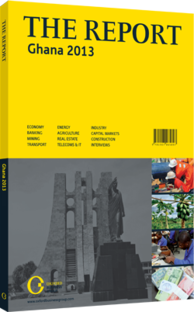GCB Bank: Banking
THE COMPANY: Ghana’s second-largest bank by total assets, GCB Bank (GCB), operates the widest branch network in the country, with 150 branches and approximately 2000 employees. GCB is listed on the Ghana Stock Exchange, with the government of Ghana holding a 21.4% stake. GCB has maintained a strong market leadership position despite intense competition in Ghana’s banking industry over the last decade, which has witnessed steady decline in the market share of top banks. GCB’s total assets in 2012 grew by 21% from the previous year; growth in assets has continued during the first half of 2013 to GHS3bn ($1.54bn) as at the end of June 2013.
The bank’s loan book recovered from the dip in 2011, when it was GHS476m ($245m) to reach GHS848m ($436m) in 2012, representing a 78% yearon-year growth. GCB’s loans and advances declined from GHS995m ($512m) in 2010 to GHS476m ($245m) in 2011, due to the payment of a significant portion of debt owed by Tema Oil Refinery (TOR). Although GCB has reduced its exposure to TOR, government entities and public institutions form the majority of its loan book and exposure profile. The bank reduced its non-performing loans (NPL) ratio from 26% in 2011 to 17% in 2012, which is still markedly higher than the 2012 industry average of 13%.
The strong performance of the bank in 2012 was driven largely by the bank’s large exposure to highyielding, risk-free government securities, which constitute approximately 50% of its assets. This helped drive growth in funded income from some GHS257m ($132m) in 2011 to GHS376m ($193m) in 2012.
Growth in the loan book and large investment in government securities were supported by a sizeable deposit base, which makes up approximately 77% of the bank’s funding sources. Deposits rose by 13% in 2012, thanks in part to the introduction of new products and improvements to the bank’s branch network.
The bank posted an exceptional growth in profits for 2012 against the backdrop of a favourable interest rate environment and a marked improvement in its NPL ratio. GCB’s net profit for 2012 grew eightfold to GHS143m ($73.5m), up from GHS18m ($9.3m) the previous year. During the first six months of 2013, the bank has continued this impressive trend, posting a net profit of GHS90m ($46.3m) for the halfyear. The bank’s stock is currently trading at its alltime high, with a trailing 12-month stock price return of 146% as of the end of July 2013.
DEVELOPMENT STRATEGY: GCB undertook a renaming and rebranding exercise during the second quarter of 2013 to reflect a shift in branding from a typical state-owned bank to a more customer-friendly and corporate-focused entity. Currently, GCB has a strong position in the retail deposits segment, but requires further penetration of the large-ticket corporate lending space in order to be truly competitive with its market competitors. A key plank of the rebranding strategy is to drive this renewed focus on large corporates and multinationals.
GCB is expected to benefit from its large investment in government securities in the short term, as interest rates remain persistently high. Interest income from government securities contributed to over 60% of total funded income in 2012. As essentially a leveraged play on domestic interest rates, the bank remains highly susceptible to changes in government securities yields and could be adversely affected by a sharp lowering of the yield curve.
The bank also plans to improve access to funding for small and medium-sized enterprises through the automation of its credit review process for this segment. This is expected to help boost loan growth with lower levels of non-payment risk. The improvement in its credit management is expected to further reduce the bank’s NPL ratio, bringing it closer in line with the industry average. A resolution passed by shareholders to increase the bank’s capital to GHS100m ($51.4m) will further expand the bank’s lending capacity and allow it to compete favourably in the industry. GCB price & index relative performance GCB market ratios
You have reached the limit of premium articles you can view for free.
Choose from the options below to purchase print or digital editions of our Reports. You can also purchase a website subscription giving you unlimited access to all of our Reports online for 12 months.
If you have already purchased this Report or have a website subscription, please login to continue.

